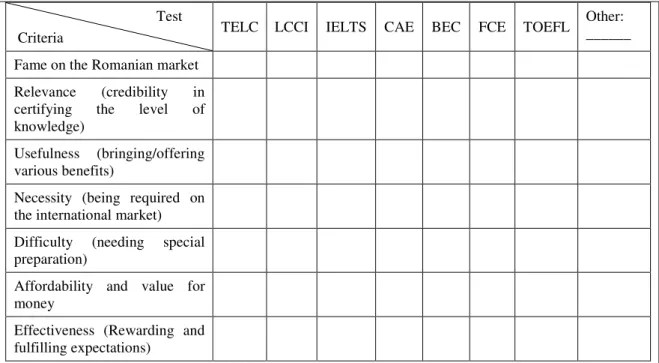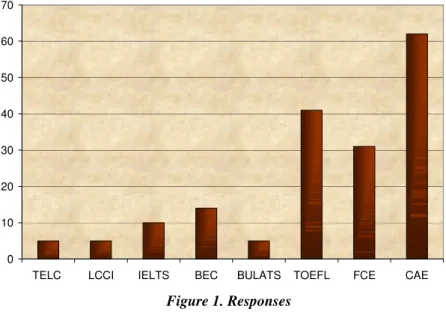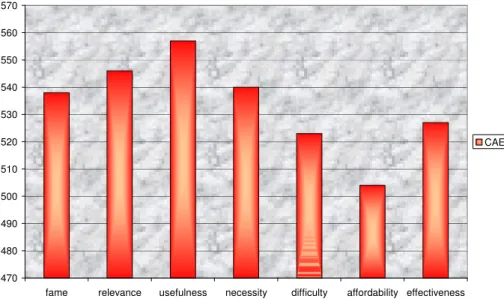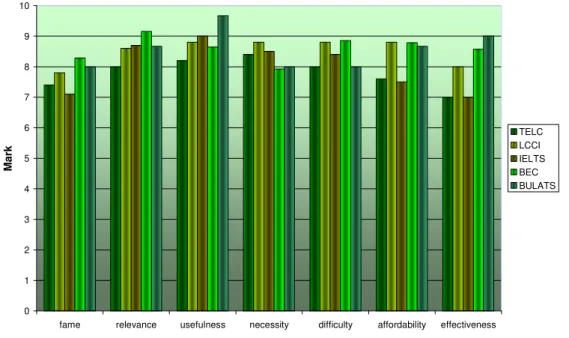ENGLISH LANGUAGE CERTIFICATES - MEETING
REQUIREMENTS OR SIMPLE FASHION -
Horea Ioana
University of Oradea, Faculty of Economics, UniversităĠii 1,
ihorea@uoradea.ro
, 0259408799The aim of the paper is to investigate the way in which internationally acknowledged language certificate tests are perceived. The questionnaire method, applied to a sample group of students, was implied in order to reveal various aspects of the expectations about these tests and certain opinions on their usefulness. Assessing several criteria, particular features concerning the perception of these tests can be remarked as initial baggage of the new students to work on and build next – as the study was conducted on first year students and thus outlines previous intakes.
Key words: internationally acknowledged language certificates, statistical overview, assessment of views
Introduction
Few researchers have studied the relevance of certain types of tests in assessing the English language skills [1]. It is rather on the sites of the centres involved or the partner institutions that one can find opinions and guidance regarding the latter. Students, in their turn, hear about the tests on special channels (mostly from teachers in high school or from colleagues, school-mates) as these examinations represent products of ‘small scale economy’, not having a very large circulation. They are clearly not designed for the large masses, but, nor are they confined to the persons involved in the educational system, as international language certifications are required for all emigrants or people looking for jobs in a foreign country. Still, it seems and it is fairly natural that the educational system is the one responsible for the implementation and dissemination of the said testing services among the youth. At the same time it can be noted that public exposure depends highly on the respective centres’ policy, marketing strategy or publicity campaign.
Research method
For a concrete determination of the needs and expectations of the students we conducted an investigation based on the questionnaire method. This form, as seen in Table 1, provides quick, extended and relevant data, easy to manipulate, compare and assess. As for the contents, it was designed to identify certain aspects. Thus, it first reveals the visibility, for the Romanian candidates, of various types of tests for language certification, and the source of their information. Then, it outlines the students’ opinions on the tests they have heard of, regarding certain criteria quantifying fame, relevance, usefulness, necessity, difficulty, affordability and effectiveness. Next, the expectations in terms of recognition are disclosed by asking all students to indicate – from a list of eight most commonly identified in the discussions with those that have taken one such tests and claim for equivalence – the ones that hold true for them in the view of a prospect registering for one of the examinations they know. This step should be the most important in understanding the misconceptions or farfetched outlooks and correcting their attitudes towards the tests in order to prevent future disappointments or inappropriate complaints.
1. Tick in the blanks next to the names of the tests for English Language Certificates you've heard of: TELC __ ; LCCI __ ; IELTS __ ; CAE __ ; BEC __ ; FCE __ ; TOEFL __ ; other (name: ________ ).
2. Where did you find about such tests?
Teachers__; Colleagues__; Internet__; Brochures__; Mass-media__; other (specify: _________)
Test
Criteria TELC LCCI IELTS CAE BEC FCE TOEFL
Other: ______ Fame on the Romanian market
Relevance (credibility in certifying the level of knowledge)
Usefulness (bringing/offering various benefits)
Necessity (being required on the international market) Difficulty (needing special preparation)
Affordability and value for money
Effectiveness (Rewarding and fulfilling expectations)
4. Tick from the following those that you would expect in terms of further acknowledgement after taking one of the examinations specified:
- by the Romanian Ministry of Education, instead of the Baccalaureate Examination in English __ - by the Romanian Universities, instead of entering examinations in English __ - by any future teachers, as replacements of marks for the tests within future education programs __ - by international companies, in order to get jobs in Romanian subsidies __ - by managers of various firms involved in relationships with foreigners __ - by companies in English speaking countries in order to get jobs abroad __
- by diplomatic institutions (consulates, embassies) in order to obtain a visa __ - by academic institutions (universities, research centers) in order to get scholarships abroad __
Table 1. Questionnaire applied to a sample group of 1st year students in Economics and Law
Synthesizing, classifying and assessing the results
Applied to a sample group of first year students, 80 in number, the questionnaire provides information as for how much the high school graduates know about the English language competence tests of international recognition and exactly which they would consider more appropriate and why. The responses at the first question are synthesized in Figure 1, where we can note the number of answers certifying student’s knowledge of the named tests. The chart makes it clear that there are certain tests obviously leading on the market, while others are barely heard of at the level of high school education and with the young university students.
Business Language Testing Service, whereas The European Language Certificate and the one awarded by the London Chamber of Commerce and Industry were heard of rather by chance.
Figure 1. Responses
The results obtained from the third question were statistically operated on, being introduced into a calculation programme. They were such grouped that analysis could be further developed on similar levels. This approach will thus show a fair assessment, comparing outcomes alike. The relevance of this separation is obvious taking into account that it is only this way that results with high representation – and thus very little margin of error (as providing an average based on numerous instances) – can be distinguished from the ones with poor occurrence – which therefore present increased inaccuracy (their average being calculated form rather few examples, and thus not really pertinent).
The classification of the results will follow the averages of the marks given by the students, considering the seven criteria mentioned in table 1, question 3. Hence we can notice differences between the tests as well as, within the same test, between the various aspects implied by the given criteria.
Figure 2. Situation of most famous tests
0 10 20 30 40 50 60 70
TELC LCCI IELTS BEC BULATS TOEFL FCE CAE
0 1 2 3 4 5 6 7 8 9 10
fame relevance usefulness necessity difficulty affordability effectiveness
M
a
r
k TOEFL
Considering the first group, that of the most relevant testing ‘products’ on the market, as seen in Figure 2, we may notice from the very beginning a discrepancy between what is believed and what was previously proved as a fact regarding the fame of the tests. For instance, while coming here on the first place as viewing its fame on the Romanian market, the First Certificate in English had just before proved to be the third only.
It can herewith be detected that TOEFL seems to be the less famous or necessary and has an overall qualification visibly poorer than the other two tests, which is understandable as it is known to be useful especially for the USA, a destination not very close for Romanians to take. While the two most famous Cambridge certificates hold really comparable positions, it can nevertheless be remarked that the Advanced English certificate is perceived as the more relevant, useful, necessary, efficient and, what is natural, the more difficult. All in all, it gets the highest average, if summing the criteria marks, as it does not run below 8 but reaches as much as 9, the highest level here.
For the most appreciated test, CAE, a more thorough investigation was conducted, and the total points gathered were taken into consideration, for a better observation of the concerns or worries as well as of the favourable opinions regarding this test. Analyzing the whole length of the scale, the extended area will easily hold true for the fact that the differences between the various criteria are much more relevant, as seen in the chart drawn in Figure 3.
A real concern for the affordability is remarked but it can be set against the very high usefulness, and the relatively small problem generated by the degree of difficulty, as compared with the impression of relevance and necessity that it triggers in the minds of the students, will create a successful combination so there is no wonder that this test acquired the bets rates. There isn’t harmony but a special balance governing the relevant criteria, which proves a winning formula. One aspect is still to be debated: that of the rather low effectiveness, given by the high expectancies, as it will further be seen from the answers for the fourth question of the questionnaire.
Figure 3. Total points acquired by CAE
The second group brings about less important information as it is assessed from a very small group, as aforementioned, and therefore not proving enough consistency and reliability. The fact that there are rather few people familiar with some of the tests mentioned here is explainable; the European Language Certificate, for instance, does not insist too much on its product recognition, simply stating their conformity with CEFR and mentioning the advantage of enhancing the CVs [3] are not enough. Still, the results obtained are represented in the chart provided by Figure 4, with TELC and LCCI proving most constant in their medium evolution, with BEC getting good qualifications but being perceived as rather unnecessary, IELTS obtaining lowest rates of fame and effectiveness, but seeming to have gained quite big
470 480 490 500 510 520 530 540 550 560 570
relevance and usefulness and BULATS, showing rather inconsistently the highest usefulness combined with low necessity.
Figure 4. Situation of less famous tests
Comments on the aspect of acknowledgement
The fourth question in the questionnaire reveals the students expectations in terms of further acknowledgement of the international language certificate tests, in general. The eight items which the students considered, in the questionnaires, are presented in the same order but shortened headings, in Figure 5, where the percentages of the student’s replies can be noted.
Figure 5. Percentages of expectations concerning further acknowledgement
As foreseeable, the expectation that companies in English speaking countries would acknowledge these certificates from candidates to the jobs they offer abroad, is the highest. 71% of the students questioned considered this as one of their expectations in terms of acknowledgement. The percentage could have been even higher, we would dare to say, as, indeed, it is mostly this that the usefulness of the tests mentioned consists in; when applying for all but the most insignificant jobs abroad, language certificates of
0 1 2 3 4 5 6 7 8 9 10
fame relevance usefulness necessity difficulty affordability effectiveness
M
a
r
k
TELC LCCI IELTS BEC BULATS
47.4
68.4
28.9
67.1
48.7
71
53.9
65.8
0 10 20 30 40 50 60 70 80
international recognition are not only accepted but even required. These basic data should be provided and thoroughly clarified by the centres themselves, which those with best designed sites do. [4]
Surprisingly enough, the second position is detained by the item referring to acknowledgement by the Romanian Universities instead of admission examination in English, exceeding 68%, which is rather concerning, as there is no connection between the two things; the Romanian higher education system functions on regulations from the Ministry of Education and a certificate of linguistic competence will not normally replace the examination for admittance to any institution of higher education, maybe except particular cases, depending on the autonomy of the institutions. The same is valid for the baccalaureate or any other future examinations in English. Even if the percentages are smaller for these items, their existence, getting closer to 50 % and respectively to 30%, are really worrying as all these are signs of a major misunderstanding and misperception of the true value and nature of these tests. Expectations of permanently, from then on, being given credit for any future tests in English on the basis of once having passed a test for international recognised certificate of linguistic competence is rather absurd. That would not only be lacking common sense, for reasons easily noticeable, from evading or not respecting any curricula to the impossibility of equivalence of a grade in one test with dozens of marks further needed to complete one’s education throughout university or other learning programmes, but also get to finally demolish the whole educational system with no need of foreign language studies beyond the level of the 11th or 12th grade when high school students generally sit for such exams of linguistic certificates.
International companies could indeed require certificates even for local jobs (in Romanian subsidies), though it is not a very relevant matter, and thus the percentage obtained by the item may be a bit too high. Anyhow, it is nothing harmful here as long as it may become a trend or even a must with the opening of the Romanian economy to the international market. It will surely become more relevant in the future, so it seems to be more of a forecast. Almost the same percentage is acquired by the item referring to the recognition by academic institution in getting scholarships abroad. As in the case of getting jobs abroad, this percentage should be higher as it is also a primary reason why this testing system was implemented. Still, it depends also on the students needs, and it may be implied that they do not want to take those steps (jobs or scholarships abroad). They may be considering sitting for the examination for a different reason, from that of being en vogue and all the friends or colleagues taking it, to that of wanting to please parents or teachers or that of simply seeing how it is or wishing to test his or her own abilities, skills and knowledge of English. Other reasons, as being demanded by the Romanian employer engaged in business with foreign partners or as wishing to obtain a visa are being represented in the chart and, in our point of view, are both quite correctly assessed, in terms of relevance, as the percentages show.
As a conclusion, we may note that the questionnaire shed light on some important aspects regarding the expectancies students attribute to the test for language certificate internationally recognised. Misunderstandings as for the acknowledgements provided should be identified and corrected in order to prevent future disappointments. Another remark is that especially the students in Economics should be better informed about the tests on their speciality, and it seems to be a duty of the English teachers in Faculty of Economics to guide them towards tests as BEC, BULATS or LCCI.
Bibliography
1. Micheline Chalhoub-Deville, Carolyn E. Turner, What to look for in ESL admission tests: Cambridge certificate exams, IELTS, and TOEFL, System 28 (2000), 523-539
2. http://www.ets.org/Media/Research/pdf/CEF_Mapping_Study_Interim_Report.pdf 3. http://www.telc.net/index.php?id=482&L=4



